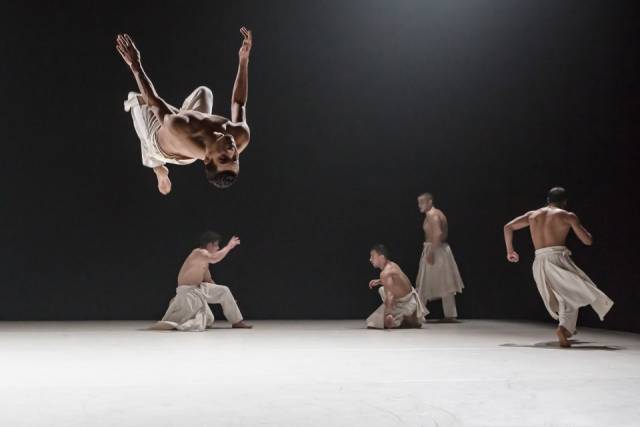

New York City Center’s annual Fall For Dance Festival, which began on September 30, features works by twenty companies over ten days. The stage is, by default, set for variety, and in this year’s second program, there was certainly no shortage of that.
The night opened on the US premiere of Hervé Koubi’s What The Day Owes To The Night, danced by a troupe of twelve men. The acrobatic piece began in silence that gave way to audible gasps and early applause as the dancers took flight and spun on their hands and heads for an incredible length of time. Drawing heavily on Capoeira and alternately set to music by Bach and Hamza El Din, Koubi’s choreography adopts an air of somber ritual that is almost dervish-like in its nearly constant motion. Moving in alternating masses, solos, duets, and trios, the dancers’ movements parallel each other; what occurs on the floor occurs, mirrored, in the air. Punctuated by partner work and gravity-defying lifts and tricks, the choreography weaves these twelve men in, out, and through each other, creating a fabric of whirling bodies that made this piece truly extraordinary to watch.
The second piece in this program, Steven McRae’s self-choreographed solo Czardas, was part Riverdance, part ballet, and all fun. Mr. McRae’s tap dancing is equal parts witty and impressive, as intricate, carefully executed footwork took him en manége at a speed one would think dangerous, and the taps lessened friction enough for eight, ten, countless pirouettes, always ending with a sassy pose that poked fun at itself. Dancing to Vittoria Monti’s Csárdás, the Royal Ballet principal put on a show that had all laughing and cheering.
Pam Tanowitz’s One Last Good Chance opened the second act, set to music performed by the composer, Greg Saunier, and the Flux Quartet. While Ms. Tanowitz’s dancers, American Ballet Theatre’s Tyler Maloney, Calvin Royal III, and Devon Teuscher, were impeccable, and the choreography pointed and full of impressive technique, the piece fell somewhat flat when juxtaposed with the night’s other offerings. Reading as a deconstruction of ballet, with technique accented by echoing, angular movements, the piece hinted at humor without actually bringing laughter to the audience. At one point, Mr. Royal approaches the musicians, upstage, and inspects them quizzically. The most interesting aspects of the piece were the costumes and the backdrop (or lack thereof), which offset each other beautifully with geometric patterns and red accents. The piece was executed wonderfully, but lacked enough dynamic energy to be among the top of the night.
Alvin Ailey American Dance Theater closed the show with a performance of Ronald K. Brown’s Four Corners. As always seems the case with Ailey dancers, they appear liquid onstage—making it look easy, though the full cast is almost always onstage. Set to music by Carl Hancock Rux, Brown’s choreography undulates in a progression that brings the dancers from burden to lightness with poetic and heart-wrenching expression. The piece is as much a testament to Brown’s choreography and Rux’s music as it is to the ability of the dancers themselves. Rachael McLaren, depicting one of the four angels, was incendiary in this closing piece. Her performance radiated energy and embodiment of both Rux’s lyrics and Brown’s movement, lifting the entirety of the piece to a truly special level, and the audience to their feet.
Fall For Dance continues at New York City Center through October 11, 2015.